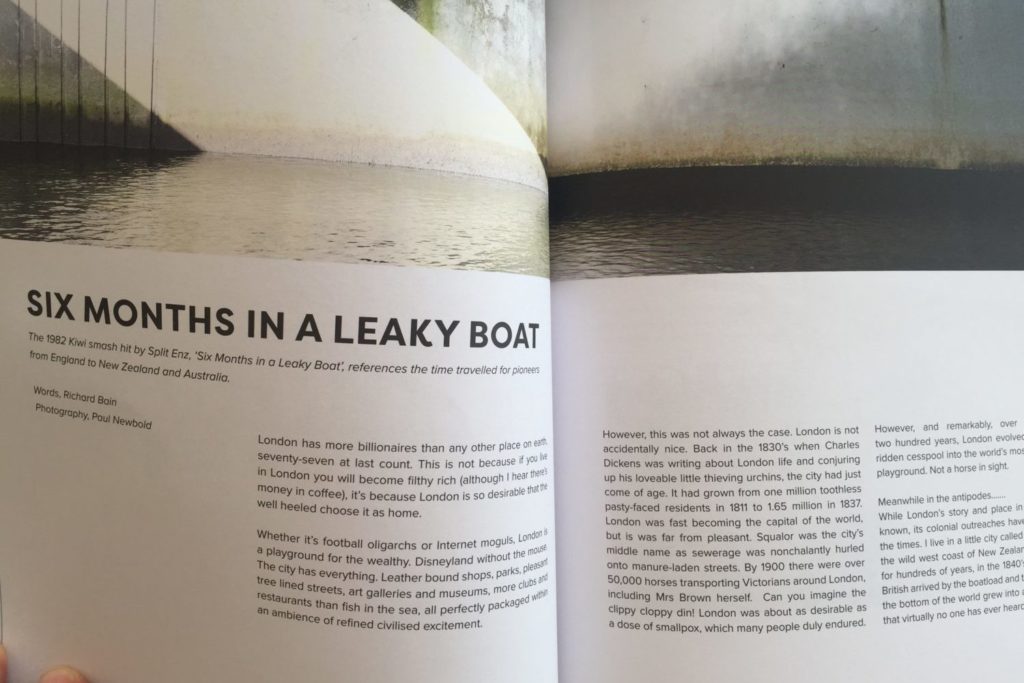Six Months In A Leaky Boat
London has more billionaires than any other place on earth, seventy-seven at last count. This is not because if you live in London you will become filthy rich (although I hear there’s money in coffee), it’s because London is so desirable that the well heeled choose it as home.
Whether it’s football oligarchs or Internet moguls, London is a playground for the wealthy. Disneyland without the mouse. The city has everything. Leather bound shops, parks, pleasant tree lined streets, art galleries and museums, more clubs and restaurants than fish in the sea, all perfectly packaged within an ambience of refined civilised excitement.
However, this was not always the case. London is not accidentally nice. Back in the 1830’s when Charles Dickens was writing about London life and conjuring up his loveable little thieving urchins, the city had just come of age. It had grown from one million toothless pasty-faced residents in 1811 to 1.65 million in 1837. London was fast becoming the capital of the world, but is was far from pleasant. Squalor was the city’s middle name as sewerage was nonchalantly hurled onto manure-laden streets. By 1900 there were over 50,000 horses transporting Victorians around London, including Mrs Brown herself. Can you imagine the clippy cloppy din! London was about as desirable as a dose of smallpox, which many people duly endured.
However, and remarkably, over the subsequent two hundred years, London evolved from a cholera-ridden cesspool into the world’s most desirable urban playground. Not a horse in sight.
Meanwhile in the antipodes…….
While London’s story and place in the world is well known, its colonial outreaches have also moved with the times. I live in a little city called New Plymouth on the wild west coast of New Zealand. Home to Māori for hundreds of years, in the 1840’s snappily dressed British arrived by the boatload and this remote place at the bottom of the world grew into a small modern city that virtually no one has ever heard of.
And yet, this mini metropolis has a level of wealth and amenity that if everyone knew about it would be immediately inundated with smiling faced optimists.
While post war growth is responsible for the city’s overall development, a significant period in New Plymouth’s maturation came in relatively recent times thanks to a surge in urban regeneration. As recently as only a dozen years ago, a good cup of coffee was as elusive as a Macfarlane’s wallet, and although a coastal city, the sea was hidden behind a bevy of rail-yards and concrete. It was as if the six months in a leaky boat it took to arrive from mother England cured everyone of ever wanting anything to do with saltwater again.
In the mid 1990’s this changed. The sharemarket dreams and big hair of the 80’s collapsed, and the city resolved to make itself better. New Plymouth’s urban regeneration was about to begin.
Over the subsequent twenty years, the city has progressively reinvented itself from a utilitarian backwater to the front pages of Lonely Planet. Thanks to a rich combination of visionaries and collaborators, a shared purpose was established, borne from distinctive regional identity. Designers, business owners, council and residents came together to shape the city in a series of projects ranging from snazzy streetscapes to ponsey pizza plazas.
Significant amongst these developments was the initial redefining of the main retail heart. Adorned with andesite bluestone, smart deciduous street trees and mountain to sea imagery, the central city set the tone for urban renewal.
This regeneration immediately prompted the city to take a look at its coastal connection. Ignored for so long, and like so many other cities separated by road and rail, the coastal walkway project would finally and resolutely reconnect the city with the sea. Creating this link also involved working with tangata whenua (Te Āti Awa) who owned a significant area of the foreshore. Shared values around landscape and recreation, especially for children resulted in the creation of open space and play structures at the centre of a 13 km walking and cycling project that hugs the city’s coastal edge like a lover’s long embrace.
On the back of the hugely successful coastal walkway project, regeneration accelerated as the community discovered its own doorstep. New urban-shared spaces centred on Puke Ariki Library and Museum were created, and the Huatoki stream plaza completed the link from city to sea. All of sudden, New Plymouth seemed to have found itself.
Contemporary arts had always been strong in New Plymouth and as home to the works of kinetic sculptor Len Lye a new shiny stainless steel curtained gallery has recently been built. Citizens and visitors can now literally look at themselves in reflected artsy cool.
With the big pieces in place and a new vibrancy in the air, the hospitality and business sector have well and truly come to the party. The newly branded ‘West End Precinct’ that includes regentrified buildings and boutique hotels, now boasts business and pleasure that your average hipster would be happy to be seen dead in. Throw in the annual Operatic Society showstopper and World of Musical and Dance (WOMAD) hippiefest; the place is busier than a one armed barista.
London and New Plymouth. Half a world apart, yet so much in common. City-making is the new game is town as the world moves relentlessly to be with each other. By 2050 most of the planet’s population will live in cities, and it’s competitive. The pressure is on for cities to regenerate and evolve into places for people to live, work and play. To attract the requisite perky folk, cities have to offer their own distinctive texture and flavour – to be savoured longingly. Thanks to a common vision and collaborative mindset, New Plymouth is well underway.
This piece appeared in, Regeneration, Ozone Coffee Roasters Journal , volume four

